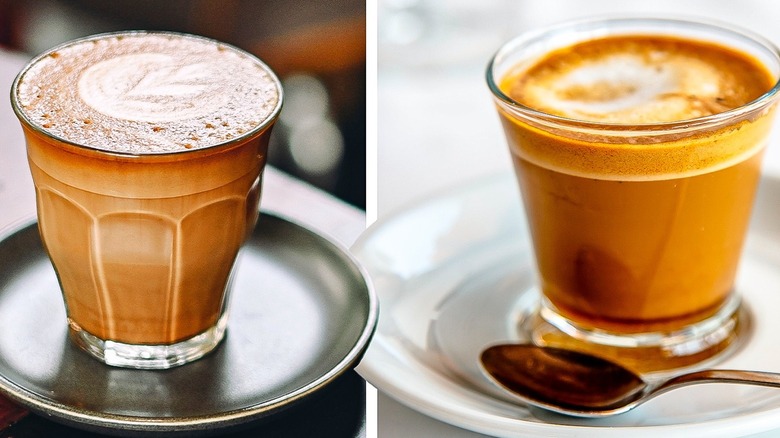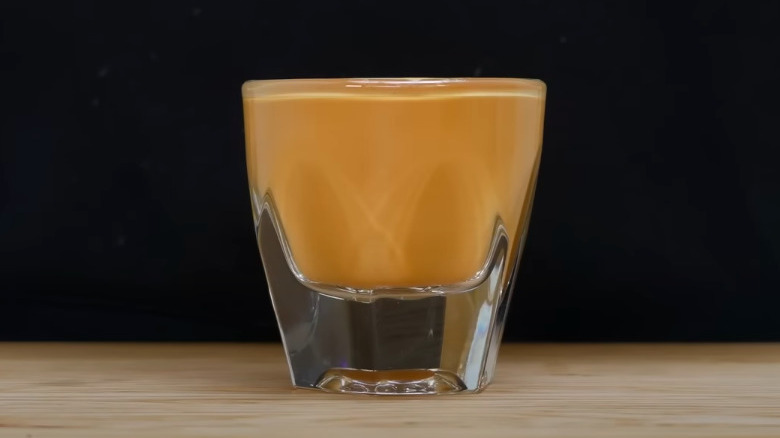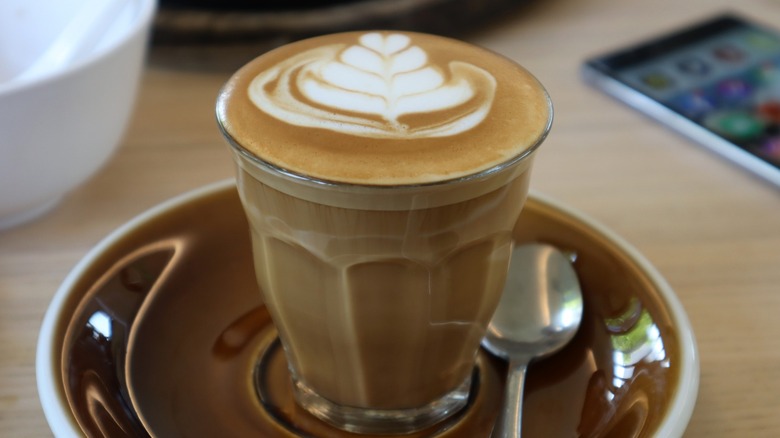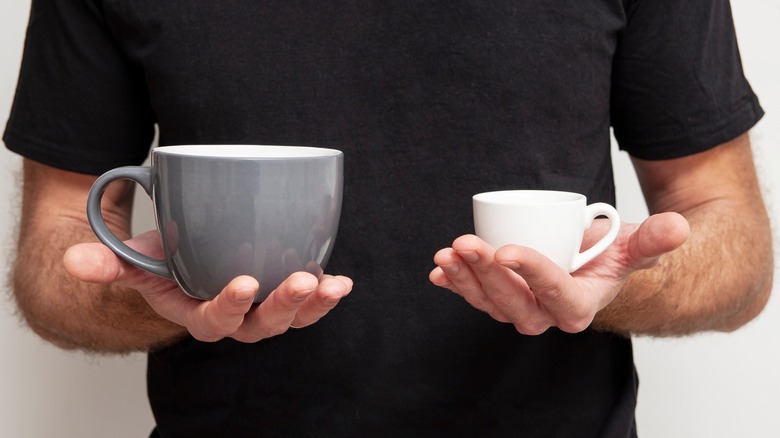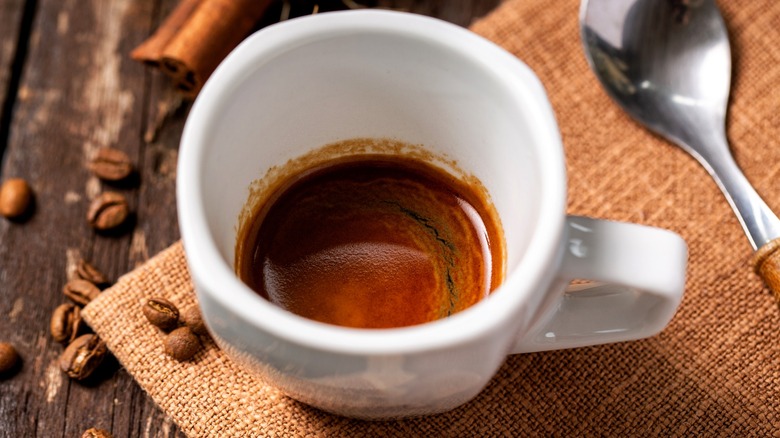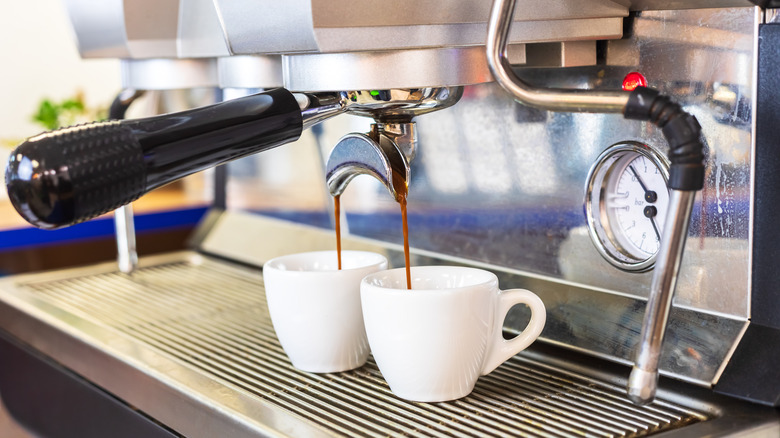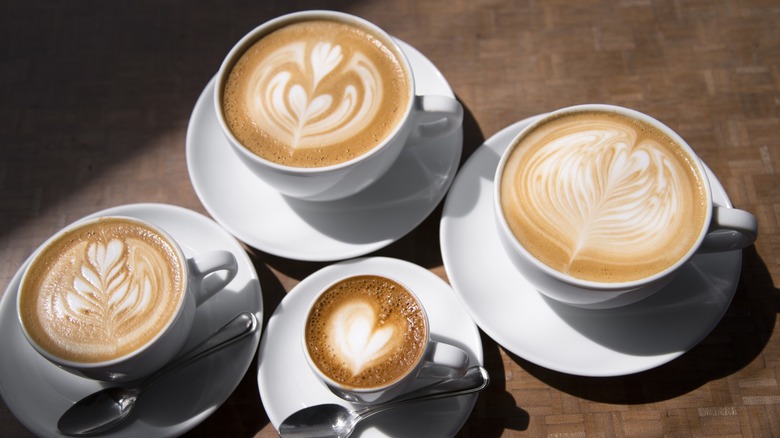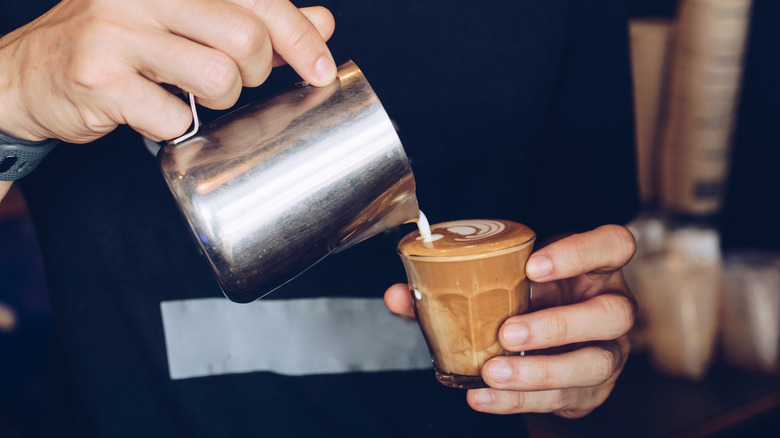Is There A Difference Between A Piccolo And Cortado?
In the coffee world, there is a whole list of different styles of drinks — all more or less made from the same two things: coffee and milk. From lattes to cappuccinos, and cold brew to drip, every type of coffee drink calls for a specific brewing or extraction method, a unique serving vessel, and specific amounts of steamed or frothed milk or milk foam. Some, however, have differences that aren't quite as obvious. Take the piccolo and the cortado, for instance.
The piccolo and the cortado are two of the few existing coffee drinks that, interestingly enough, do not hail from Italy. But despite their miniature serving sizes and espresso-forward flavors, that's about the only thing these two drinks have in common. So, while the two might look related — considering the piccolo's ties to Australia and the cortado's origins in Spain — they're really worlds apart. Let's sip through their differences together, shall we?
What is a cortado?
Before we can understand the differences between the cortado and piccolo, we first have to understand what they are. The cortado, while perhaps more commonly known, is a small espresso drink from the Basque region of Spain that's often confused with similar drinks of rhyming names. What makes the cortado a cortado and not a piccolo, affogato, or macchiato, however, is that it's made with equal parts milk and espresso. Hence its name "cortado" — the Spanish word for "cut."
The experience of drinking a cortado, in turn, is much more espresso-forward than, say, a latte or cappuccino. However, the "cutting" of the drink's 2 shots of espresso with milk means that it still gets rounded out, reducing the acidity and bringing all of the espresso's sweet, chocolatey, and nutty notes to the forefront. While it does also bring the drink a hint of creaminess, the cortado is unique compared to other coffee drinks in that the milk is only lightly steamed without any froth or foam.
What is a piccolo?
Compared to other varieties of coffee beverages, the piccolo isn't an easy order to come by — although enthusiasts might get lucky at a Starbucks Reserve. These teeny, tiny drinks are much more popular in Australia, the coffee-loving country where they originated. Named after the Italian word for "small," the piccolo is a reflection of the inherited coffee culture Down Under, brought there by Greek and Italian immigrants during World War II. In turn, the piccolo is a drink that heroes the taste of the beans. Like the cortado, piccolos are made with the intention of accentuating the espresso itself, using only just enough milk for all of its flavor to shine, and no more.
The piccolo is unique because it uses 1 part espresso to 2 parts steamed milk, specifically pouring what's known as a single ristretto espresso (a smaller and more concentrated espresso shot). Served in the usual 85 to 110 milliliter glass, a recipe will typically call for about 20 to 30 milliliters of espresso and 40 to 60 milliliters of micro-foamed milk. As a result, the experience of drinking a piccolo is very nuanced. With only very slight differences to the cortado in texture, flavor, and presentation, the two can be difficult to differentiate — but there are a few key differences.
Piccolos are served in smaller cups, yet contain more milk
A lot of coffee drinks, including latte macchiatos and macchiato espressos, are served in specific vessels — and so are piccolos and cortados. One of the major differences between them, in turn, is that the two are served in different sized cups. While it can depend on where you get one, a piccolo is most often served in a small glass, ranging between 85 to 110 milliliters, or 3 to 4 ounces, while a cortado is typically served in a glass between 110 and 120 milliliters, or 4 ounces. As you might expect, the piccolo offers a smaller serving size than your typical cortado. That much can be confirmed just by looking at them side by side.
Now, if you're someone who prefers to get more quantity for your money, then that'd make a cortado your go-to. But there is something to be said about what's inside of those glasses, too. While neither one is better than the other, one could be more your cup of tea (or, in this case, coffee). When it comes to the cortado and piccolo, it's not just about the size of the cup, it's about what's in it. Both drinks are made with different ratios of milk to espresso, with the piccolo containing ⅔ milk compared to the cortado's ½. But they're also made with different types of espresso shots.
Piccolos are made with ristretto espresso
As mentioned before, piccolos are unique because they're made with a special style of espresso known as ristretto espresso. Ristretto pulls, as compared to a standard pull of espresso, are much shorter — only requiring about 12 to 14 seconds of extraction time compared to the standard 25 to 30 seconds. In turn, a ristretto shot contains significantly less water, which makes its flavor even more concentrated. But what exactly does that mean for your piccolo? The ristretto espresso shot used to make piccolos is small but mighty, delivering a sweeter and richer flavor, thicker body with more crema, and a longer lingering mouthfeel as compared to the standard espresso used in a cortado.
So, while the piccolo does have a higher ratio of milk to espresso than the cortado does, the espresso itself is also much more concentrated in flavor. Considering that, you might not notice much of a taste difference — but it's certainly there. Despite being more concentrated than a standard espresso shot, the ristretto used to make a piccolo is comparably less bitter. That, mixed into the slightly higher amount of milk, gives the piccolo a much lighter and sweeter sip than its cortado counterpart.
Cortados deliver a slightly stronger coffee flavor
While the ristretto style of espresso that is used to make a piccolo is technically more concentrated than the standard style used to make cortados, the cortado still comes out tasting noticeably stronger. A lot of that can be handed down to the fact that, in being made with equal parts espresso and milk compared to the piccolo's one part to three, the cortado's espresso is significantly less "cut" through. But it's also partly due to the standard espresso shot having more of a bitter and intense coffee flavor in the first place.
Knowing that, if you're choosing between a cortado and a piccolo, cortados are the drinks to order on your next coffee run if you prefer that kind of flavor intensity in your drinks. Although the milk definitely helps to mellow out some of the more acidic notes of the coffee while introducing those creamy and sweet textures, the fact that there is slightly less of it combined with the simple truth of the espresso tasting stronger only means that it shines more — and in all of the brightest ways. The acidity is balanced, and the sweet, nutty flavors are accentuated.
Cortados come in two different sizes in Spain
Most people will tell you that a cortado is only a cortado, but those people likely haven't had one in Spain — particularly in the Basque Country, where they can be ordered as "cortados" or "cortados largos." It's a bit confusing, because if you asked for a "large cortado" in the U.S., the barista would look at you funny. If you asked for a "cortado largo" in Spain, on the other hand, they'd understand exactly what you meant — even if the order itself is an oxymoron. Then, they'd give you a drink that's closer to a true cortado, with equal parts espresso and milk. It's puzzling, but it's only indicative of the differences between the two coffee cultures.
Cortados are the most misunderstood coffee drinks in the U.S. because they've been grouped with Italian lattes and cappuccinos, leading people to believe they can get them in bigger and smaller sizes, when, in truth, a larger cortado only means more milk is added. That, in turn, changes the flavor balance completely so that it's no longer a cortado. The difference in Spain is that cortados are usually made slightly stronger, with more espresso than milk. Ordering a "largo," by default, only brings the two back into equilibrium. If you are particular about the amount of milk in your cortado, one tip to follow to avoid confusing your barista is to order the steamed milk on the side. Then, add it to your espresso yourself.
Piccolos don't hold back on the foam
While opinions on whether microfoam is technically considered a milk foam certainly vary, most people can agree that cortados should not come with a layer of froth on top of them. Instead, the milk in a cortado should only be slightly steamed. This, in turn, creates a microfoam that distributes throughout the entire drink rather than separating and rising to the top. That way, each sip you take is just as "cut" through as the next. The piccolo, on the other hand, does come with a layer of foam on top of it.
Although it is minimal, piccolos are intended to have slightly more foam than a cortado does, creating a thin layer that sits on the top of your drink. This only plays more into the piccolo's lighter, sweeter flavor profile and goes hand in hand with its milkier ratio and smooth ristretto pull. The top foam is just another element of smoothness, giving the piccolo a slightly silkier mouthfeel and thicker texture. Having said that, if you expect to try to your hand at a little latte art in your coffee drinks, the piccolo is the way to go.
